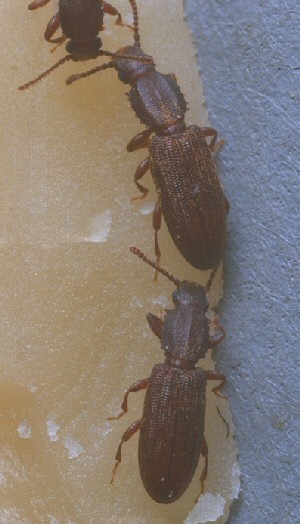Sawtoothed Grain Beetle
 Scientific Name
Scientific Name
Oryzaephilus surinamensis
Habitat
The sawtoothed grain beetle is one of the most widespread of all stored-product pests and can originate at the manufacturing, storage or retail levels. They may occur in both food products in the pantry area as well as in other adjacent rooms. Foods that may be infested include cereals, flour, pastas, dried fruits, dried meats, candies, and other similar packaged goods. As with other pantry insects, it is the larvae do most of the damage, yet it is the adult that is most commonly encountered. The adult can readily enter sealed cardboard boxes and soft plastic packages.
Life Cycle
The adult beetles usually deposit their eggs in the food stuffs they infest. A single female can lay from 45 to 250 or more eggs which hatch in 3 to 17 days depending on the temperature. The larva is yellowish white with a brown head and measures 1/8 of an inch in length when fully grown. The larval period lasts from 2 to 10 weeks after which they pupate by sticking together small bits of the food material to form a protective covering around their bodies. The pupal stage lasts from one to three weeks after which the new adults emerge. The adults are long-lived and have been kept alive for over 3 years. Under ideal conditions the life cycle is completed in about 30 days.
Description
The adult is a small, active, brown beetle, 2-3mm long, with a flattened body and six saw-toothed projections on each side of the thorax. The larva is yellowish-white, about 2-3mm long, with a brown head. The abdomen tapers toward the tip.
Control
Control of these insects involves inspection and removal of infested food products, discarding the heavily infested material, repackaging material in new containers, and vacuuming kitchen cabinets. Products that need to be retained may be placed in the freezer for several weeks to kill adults and larvae.
